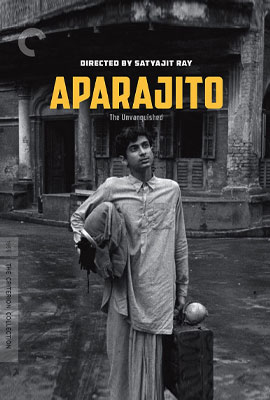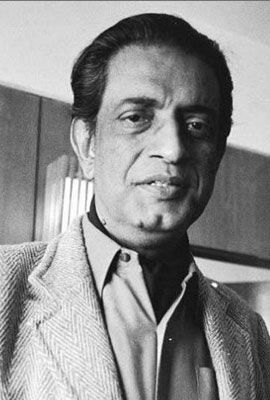
(1956)
directed by Satyagit Ray
“Aparajito” is the second film in Satyagit Ray’s magnificent Apu trilogy. “Aparajito” means “Unvanquished.” I discussed the first film in the Apu trilogy, “Pather Panchali,” in Chapter 3, “Spirited Away.” “Aparajito” begins with the camera looking out the window of a train. The train races across a bridge and steel beams flash by as Apu’s family leaves the country for the city.
Apu’s story resumes in the holy city of Banares where his father earns a living as a priest. Apu has turned the alleys, the temple stairways, and the river banks into his personal playground. We see Apu balancing on ledges and peeking around corners.
Apu’s father performs religious services for groups of pilgrims who have come to bathe in the holy Ganges river. His beautiful speaking voice is well suited for reciting religious passages and is admired by a fellow priest. Later in the film, when Apu is asked to read a passage at school, his flawless delivery is noted by the headmaster and reminds us of his father. Apu’s family expects him to follow his father’s example and eventually become a priest.
The family home in Banares shares a courtyard and a water spigot with neighbors. Apu’s mother is just as worried as ever. She seems especially apprehensive about a middle-aged man who is a close neighbor. For the most part, though, her worries are unspoken. Throughout the film, the characters communicate with their eyes and with physical gestures. They rarely speak to one another about what is on their minds. The heavy weight of tradition and family expectations does not permit family members to discuss their various concerns. Conversation is limited to whatever is necessary for day to day life. Even something as simple as a shopping list is discussed with seeming reluctance.
Coming of age, as presented in Ray’s film, is very different from our modern experience. We think of experiences like a first kiss or falling in love. The catalyst for change in “Aparajito” is death. Apu’s father falls ill and dies after a brief illness. We are startled when the moment of his death is marked by the sudden flight of a flock of birds. Death is a time of great sorrow but also frees Apu to seek his own path. Apu is an excellent student and wins a scholarship to study in Calcutta. His mother goes to live with an uncle in the country.
Apu’s relationship with his mother is the central concern of “Aparajito.” The film observes truths that are found in all cultures. The parent makes sacrifices for years and years only to see their child move away into adulthood. When Apu visits his mother during school vacations he sleeps or loses himself in his books. He is in a hurry to return to school and barely speaks to his mother.
The mother’s life towards the end of the film is sorrowful and heavy with impending doom. Will she die alone and unloved like the old auntie in “Pather Panchali?” Apu’s final visit to see his mother is a heartbreaking sequence. He calls out her name and searches for her throughout her home. The camera remains outside and observes his search from a distance. When Apu realizes his mother has died, he joins us outside. He is now truly on his own.
Satyagit Ray

Satyagit Ray, the director of “Pather Panchali,” started his career as a commercial artist. He was drawn into film making after meeting the French director Jean Renoir and after seeing Vittorio De Siva’s Italian neorealist film “Bicycle Thieves” during a visit to London.
When Ray started filming his movie “Pather Panchali,” he had never directed a single scene, his cinematographer had never filmed a single scene, and his child actors had never acted. Despite all this inexperience, early footage was so compelling it helped Ray obtain financing for the rest of his movie.
Inexperience may have actually fostered creativity. At the time, movie crews waited for good weather and shut down production if it was raining. Ray followed his instincts and solved problems like how to film in the midst of a rain storm with umbrellas, tarps, and a “must do” attitude.
Ray was the first Indian to receive the Academy Honorary Award for his tremendous impact on film making. Ray was the second film personality after Charlie Chaplin to be awarded an honorary doctorate degree by Oxford University. Ray also received numerous other awards and honors including the Commander of the National Order of the Legion of Honour, the highest decoration in France.
Ray’s genius was matched by his humility. According to the leading actor Babita, “One of the most remarkable experiences working with Satyagit Ray was when one day, while shooting, I had to cross a small bridge on foot. I had to take my slippers off and forgot to pick them up. When I turned around, I was shocked to see that Mr. Ray was carrying my slippers! This was a lesson in humility that I’ll never forget.”
Ray was a hands on director. His script writing and directing were accompanied by his meticulous set and costume designs. He designed the calligraphy for the opening credits, selected the cinematography, composed the music (sometimes in collaboration with composers like Ravi Shankar), and designed the posters for his film releases.
Satyagit Ray was a director of breathtaking talent and breadth. Ray took the earth, the sky, the rivers, and the clouds, introduced his simple, heartwarming stories, and fashioned his characters from the ordinary people of his beautiful country.